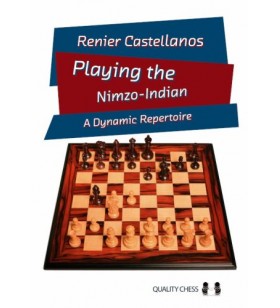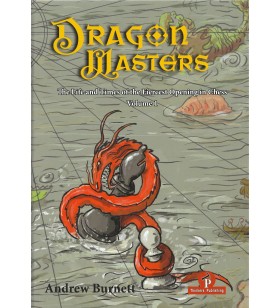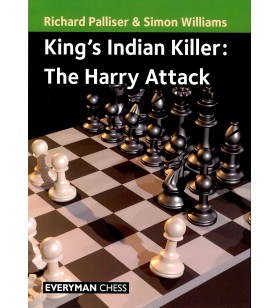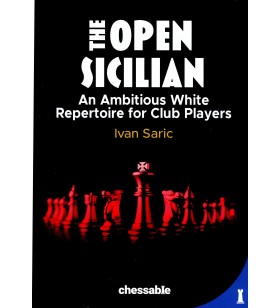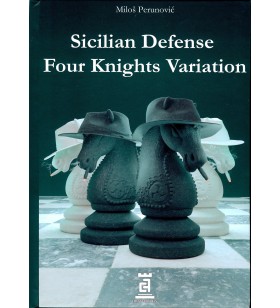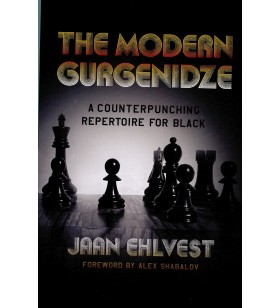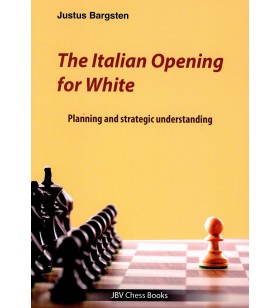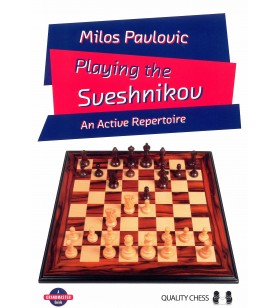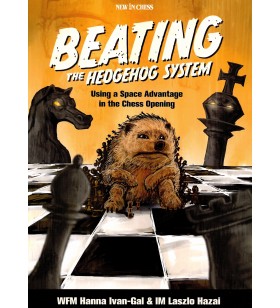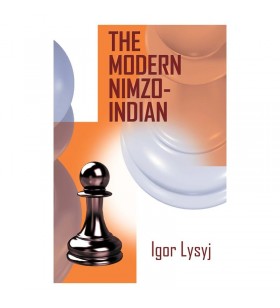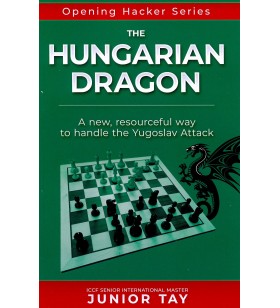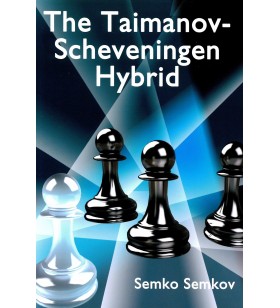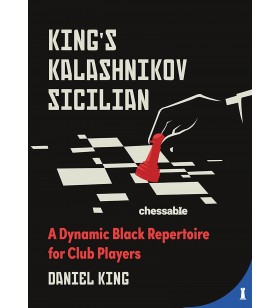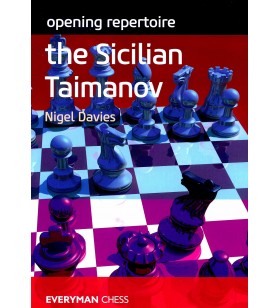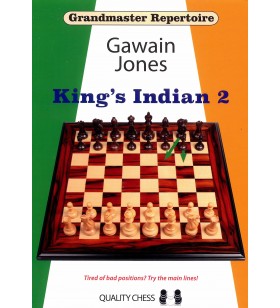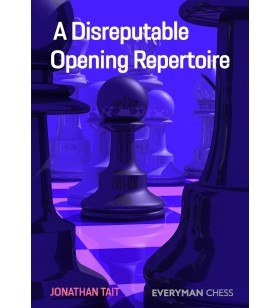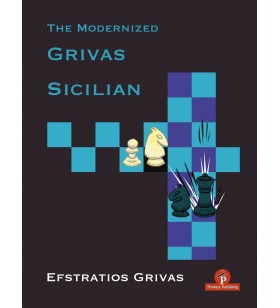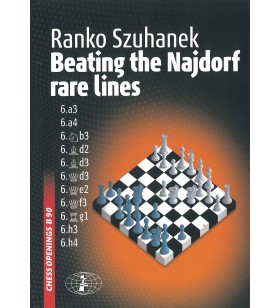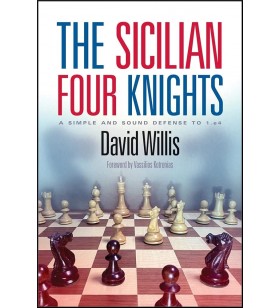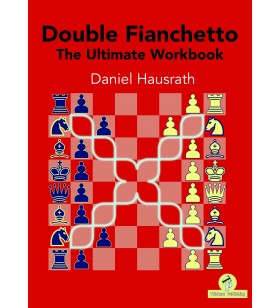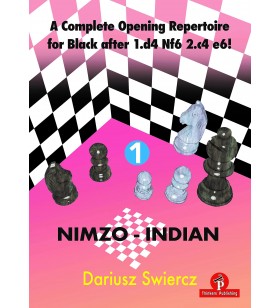
Active filters
Burnett - Dragon Masters (The life and Times of the fiercest opening in Chess Volume 1) Hardcover
Andrew Burnett is a Scottish FM who has represented his country on several occasions. He is the author of cult classic Streetfighting Chess and his love of the Dragon opening stretches back to his teenage years when he was looking to escape from 1.e4 e5! He is currently working on the second volume of DragonMasters.
DragonMasters volume 1 charts the history of the most exciting and dangerous opening known to chess: the Dragon variation of the Sicilian Defence.
Unlike almost all other books on the Dragon, the focus is not purely on theoretical developments. Instead, the author has combined the most historically important games, the famous players who chose to fight either side (sometimes both sides!) of the opening, and the most unexpected and interesting stories featuring the Dragon. World champions, contenders for the crown, codebreakers, revolutionaries in every sense of the word, all feature in this remarkable and entirely unique look into the history of an opening variation. As the ancient maps say: Here be Dragons! 404 pages Hardcover
Kotronias - The Safest Scandinavian Reloaded
A completely revised edition, which retains the structure of the first edition but is based on new analysis of all critical lines.
This book presents a Black repertoire based on the Scandinavian Defence with 3...Qd6. This is the safest yet aggressive queen retreat. It allows Black to increase pressure on d4 with ...0-0-0 or ...Rd8 while keeping coordination in the centre. Kotronias offers new plans for Black in the most topical lines. They are backed with deep analysis based on solid chess understanding.
As Kotronias puts in the introduction chapter:
"(...) Instead of reprinting the book, the publisher offered me to make a new, revised edition. It took me almost a year to analyse all the new developments and repertoire books that proposed dangerous new weapons against the Qd6 Scandinavian. Meanwhile the AI engines surged, with their original view on some positions. The result is a completely rewritten book, with major corrections, especially in its second half. The structure of variations remained the same, but I introduced many improvements in the subsequent play. I also added some games of mine from the last year." 300 pages
PALLISER, WILLIAMS - KING'S INDIAN KILLER: THE HARRY ATTACK
Do you want a simple and practical method to counter Black’s kingside fianchetto defences after 1 d4? A line that takes the initiative from a very early stage and creates difficult practical problems? If so, then The Harry Attack (1 d4 Nf6 2 c4 g6 3 h4!) is for you.
At first this looks like some sort of joke or, at the very least, a weird outlandish line. Aren’t we all taught to focus on development and control of the centre in the early stages? What’s 3 h4 got to do with that?
Perhaps surprisingly, this is a very difficult line for Black to counter effectively. This applies not just in practical play but also theoretically, where it is far from straightforward for Black even to find a route to equality. And when Black gets it wrong they are often on the receiving end of a very unpleasant miniature.
You may be thinking that surely the best chess engines can show how to counter this line? No! One of the unexpected features of leading engine play is their enthusiasm for shoving the h-pawn up the board and they fully concur that 3 h4! is a very decent move for White. Many leading players have taken the hint and 3 h4 is frequently seen at elite level.
Richard Palliser and Simon Williams (the GingerGM) provide a thorough guide to this fascinating line. They show how to adapt when Black chooses a King’s Indian set-up, a Grünfeld set-up, a Benoni set-up or even plays in Benko style.
The Harry Attack is easy to learn and is perfect for unsettling players steeped in the theory of their favourite Indian defences. 238 pages
Saric - The open sicilian. An ambitious white repertoire for club players ( Hardcover)
The Sicilian Defence is the most attractive and most complicated opening in chess. If you don't play the Sicilian with White or Black, you miss much of the beauty and the challenges our royal game offers. For White 1.e4 players, building a repertoire against 1...c5 should be their priority.
Croatian top grandmaster Ivan Saric is one of today's greatest Sicilian experts. He plays 1.e4 with White and the Najdorf with Black! With The Open Sicilian, based on his highly acclaimed Chessable course, he has managed something impressive: a watertight repertoire against the Sicilian of just over 400 pages. But reading this one volume, your knowledge of this opening and chess, in general, will make a spectacular jump.
The Open Sicilian is not a phonebook crammed with computer lines but a textbook full of 21st-century chess wisdom. Saric covers the entire range of Sicilians, from obscure sidelines to the main lines: the Najdorf, the Taimanov, the Rauzer, the Kan, the Sveshnikov, and the various Dragons. His approach, firmly based on the ideas of the English Attack, is very ambitious, and he supports his claims with deep analysis and illuminating and elaborate verbal explanation.
Saric has written a book that will serve as a standard work for many years. He offers you the content to be fully armoured against all the intricacies of all the topical Sicilian lines.
Ivan Saric (1990) is a Croatian chess player who became an International Master at 17 and a Grandmaster at 18. He became U18 European Champion in 2007, U18 World Champion in 2008, and won the European Individual title in 2018. Saric beat Magnus Carlsen for his country at the 2014 Olympiad in Tromsø.
434 pages
Bezgodov/Barsky - The scotch game a white repertoire
The Scotch Game is a solid opening that has been tried and tested in practice by some of the strongest chessplayers in the world for more than two centuries. The idea behind the Scotch Game is simple and easily understandable. White eliminates – in a purely mechanical fashion – Black’s e5-pawn which initially impedes his ambition to dominate in the center.
This is very appealing for White, as he controls the direction of the struggle’s development, while Black can only try to keep pace. Furthermore, there are relatively simple schemes in the white repertoire in which it is enough to remember the main plans of both sides and typical maneuvers.
This is the second edition of Vladimir Barsky’s book that first appeared in 2009. The new edition consists of seven chapters dealing with the core ideas and variations of the Scotch, supplemented by 79 Illustrative Games. The authors not only present detailed analysis of all lines but are also careful to discuss the ideas behind the opening. If you already play the Scotch, you need this book. If you don’t, find out what you have been missing. 224 pages
Perunovic - Sicilian Defense : Four Knights Variation
The Four Knights Variation is a variation of the Sicilian Defense that most often occurs after 1.e4 c5 2.Nf3 e6 3.d4 cxd4 4.Nxd4 Nf6 5.Nc3 Nc6. It’s a good choice for all types of players – whether you’re an aggressive player who wants to attack your opponents or a more defensive player who prefers a slow and positional game, the Four Knights Variation is the right choice for you.
Learning to play the Four Knights Variation of the Sicilian Defense is not only beneficial for adding a powerful opening to your repertoire but can also improve your general chess understanding and knowledge. By studying this opening, players can learn about important concepts such as pawn structures, piece activity, and the importance of controling the center. Furthermore, the Four Knights Variation often leads to complex and tactical positions, which can help players improve their calculation skills and ability to recognize key tactical patterns on the board. All in all, mastering this opening can help players become more well-rounded chess players. 223 pages
Ehlvest - The Modern Gurgenidze - A counterpunching repertoire for black
The Modern Defense has been popular for decades. However, within the purview of this defense, there is a system that challenges White right from the get-go. The brainchild of Georgian grandmaster Bukhuti Gurgenidze, Black plays 1...g6 and follows with a timely ...c6 and ...d5. Occasionally classified as part of the Caro-Kann, it draws battle lines immediately.
The move 1...g6 in general is an aggressive approach, throwing down the gauntlet from the very first move. This is why in some lines, even if the reader finds that the engine assesses a position in White’s favor, one should not be put off.
This book, the first one dedicated to the Modern Gurgenidze in many years, consists of 10 theoretical Chapters and 31 sample games. Jaan carefully explains how Black’s plans may change depending on White’s move order, when exactly we should play ...c7-c6 followed by ...d7-d5 (Chapters 1-5) and when we would be better off with ...d7-d6 and ...e7-e5 (Chapters 6-10). You will be treated to Jaan’s insights on Hippo, Dutch, English, King’s Indian and even 1.b3, all through the eyes of Gurgenidze system. – Grandmaster Alex Shabalov in his Foreword.
The Modern Gurgenidze has figured prominently in Jaan Ehlvest’s repertoire as Black for many years. He now shares his expertise and experience in this provocative defense. If you want to play for a draw, this book is not for you. But if you want to play for the full point, this counterpunching defense may be just what you are looking for.
About the Author:
Jaan Ehlvest is a grandmaster from Tallinn, Estonia. He won the 1980 USSR Junior Chess Championship when he was 18 and in 1983, the European Junior Championship. He was champion of Estonia in 1986 and was a member of the gold medal-winning Soviet Union team at the 28th Chess Olympiad in Thessaloniki 1988. He played for Estonia in the Chess Olympiads of 1992-2004. This is his first book for Russell Enterprises. 240 pages
Bargsten - The Italian Opening for White
With this work, the author aims to illustrate the modern ideas of the Italian Opening to players at a medium level. It deals with positions based on White's slow plan, i.e. if he chooses a calm approach characterized by positional ideas. The author does not attempt to offer the reader a complete repertoire, but rather to explain the ideas of the emerging middlegame positions. The material primarily includes the systems 1.e4 e5 2.Nf3 Nc6 3.Bc4 Nf6 4.d3 Bc5 5.c3 h6 6.0-0 d6 7.Re1 a6 8.a4 Ba7 9.Nbd2 0-0 10.h3 and 1.e4 e5 2.Nf3 Nc6 3.Bc4 Nf6 4.d3 Bc5 5.c3 d6 6.0-0 0-0 7.h3 h6 8.Re1 a5, where especially the latter has gained enormous popularity in current practice

 Français
Français Nederlands
Nederlands English
English